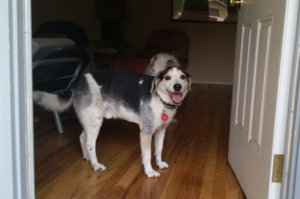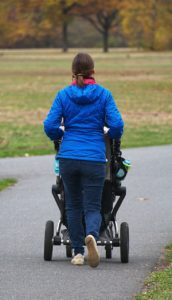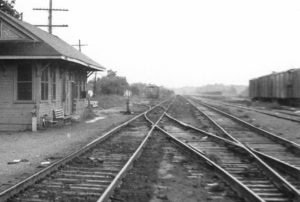
Charlie’s Big Adventure
 Medford, Oregon, April 25, 2016: I guess he’s been getting restless. I’ve been lousy about taking them for walks, and running around the back yard has probably grown passe.
Medford, Oregon, April 25, 2016: I guess he’s been getting restless. I’ve been lousy about taking them for walks, and running around the back yard has probably grown passe.
Of course, Daisy is getting old. She’s creaky, slow, and her back legs erratic. But Charlie, though almost as old, still has a lot of Get Up And Go. And the fact that Daisy is now mostly Got Up and Went gives him no pause. He’s a busy guy.
Today started out normal, like any day, and since I wanted to get soup for lunch at Great Harvest, I herded the dogs into the garage/backyard, and sure enough, the soup was swell.
When I arrived back home and parked in the driveway, behind me cars began stopping in the street, a line of them in each direction. And that was because Daisy was wandering around on Siskiyou Boulevard. [Read more…]
The Clanging of Cymbals and Bells
495 Third Avenue, San Francisco, 1975. These days I ride my motorcycle, and have plenty of spare time in between the postering runs for The Thumbtack Bugle. And while I was out putting up posters one day, I was looking at one of the posters.
I had been hired to put up a brightly colored large poster with colorful, banner-like flags pictured. It was advertising a special ritual that was to be performed by Chogyam Trungpa Rinpoche, a Tibetan Buddhist teacher, at the Nob Hill Masonic Center auditorium on California Street.
Sounded weird and maybe interesting, so I went.
I found it kind of noisy at the time — lots of banging drums and clashing cymbals and blatting, discordant horns — it was plenty weird, and I didn’t understand it much at all.
A week later I was speaking with my cousin Bruce (Richard Bruce Hurn), in Berkeley, and mentioned it because he was studying that same tradition, because they had a study center in Berkeley.
He fell upon the ground laughing. Apparently the ritual that I’d attended was a ritual for the dead.
Gosh. looks like I was in the right place after all!
Peeping and Hiding
 Wichita Falls, Texas, 1971: In my apartment I played my stratocaster. I was thin and trim in those days, and I’d picked up a girlfriend for a week or two, by the name of Mary.
Wichita Falls, Texas, 1971: In my apartment I played my stratocaster. I was thin and trim in those days, and I’d picked up a girlfriend for a week or two, by the name of Mary.
I don’t recall how I met her, but she had a teeny-tiny little apartment some dozen blocks away from where I lived, and so who knows? Maybe I met her on the street. But I’d met her somewhere, and always an eager experimenter at that time, I’d fetched her to my place for a while.
I didn’t think she was a truly pretty girl, but she was eager and earnest, and … well … those are good qualities, with the right timing.
And Mary was a devotee of something called Sloe Gin. It’s a weird kind of sweetish alcohol beverage, and she’d been drinking quite a bit of it that day there in my apartment, and she came to sit on the carpet about a foot away from where I stood, playing my statocaster.
I was rocking out. I must have thought I was pretty cool, and I was having a good time.
And ignoring Mary, for she commenced to writhe around my legs.
For just a minute there I thought I was probably Keith Richards.
But then other thoughts intruded, and we shall now pass over later events of the day. In silence.
Now, as it happened, I only kept company with Mary for a little while.
Maybe I got a better offer. Maybe I became bored with her. I no longer remember. But callous youth, I moved on, and forgot about her.
About a year later, I was walking up my street. It was a grey and overcast day, of a neutral temperature. I don’t know what I was doing, probably just taking a walk to stretch my legs. Somehow the walk got longer and longer, and when I was on the block that was near Mary’s old apartment, I was crossing the street, and about a block away, I saw Mary.
She was pushing a baby cart.
I ducked.
I jumped behind a car, and peeked out cautiously. Yup. Mary.
Yup. Baby cart.
Skulking out of sight, I went round the block in the other direction. She never saw me. With an interesting mix of thoughts and emotions flooding through my mind, I crept back to my apartment.
And that’s the end of the story.
The Wild Speedometer
Dallas, Texas, 1965: I didn’t know much about negotiating back then. I knew I wanted to buy the Morgan Motor Car, and Little John had a demonstrator for $3000. I wasn’t able to talk him down, and he wasn’t much interested in my trade-in, a faded-paint Dodge Lancer with “The Spook” written on the back.
The First National Bank of Henrietta finally came through at the end of the day, a day I’d been close to tears several times, and just as night was falling, Little John handed me the keys.
I’d never driven a sportscar. Certainly not one like this.
A Morgan is very light and low to the ground. Beneath the tan leather upholstery, you’re sitting on an inflatable cushion perhaps three inches thick, and the floor is only five inches from the ground. Kind of like driving a go-cart through traffic.
Further, the hood is long and tapering, and you’re sitting right in front of the rear axel, so when you turn a corner, it appears that the distant front end of the car turns the corner, and then some short time later, you turn the corner.
As I drove through the busy nighttime Dallas traffic in the unfamiliar car, working the gears, I suddenly realized that I was sitting so low that my head was lower than many of the headlights on other cars. The speed, the new gearbox, the flashing lights, it was all quite frightening.
By the edge of town, I’d decided to take the back way through the countryside, so that there would be less cars on the highway. Or maybe I just got disoriented and found myself on that road.
This was a smaller highway, a two-laner that wound homeward through a generally deserted woods. Once free of the city, I accelerated up to 65, then the night-time speed limit.
Wow!
In the low-slung car, it seemed like I was just flying. The tachometer kept reving up, the high-pitched engine eager. And the curves! They popped into the headlights, then I was zooming around like lightning with plenty of screeching from the wide tires. I felt like I was driving a hundred miles an hour.
When the occasional other car appeared ongoing, it was as if it no sooner appeared than zoomed past, receding tail-lights behind me. And twice I came upon other cars, just dawdling they were, oddly, all of them. I passed them like they were parked on the highway.
The mystery of the speeding car was solved the next day: The speedometer was installed wrong. What I thought was 65, was actually 95, and I’d driven all the way at that speed in the unfamiliar vehicle.
Just like Parnelli Jones. Only far more ignorant.
Carrie Street Station
 St. Louis, Winter 1967: I was saving up my money, so I got two jobs.
St. Louis, Winter 1967: I was saving up my money, so I got two jobs.
Days: Yard clerk at the Rock Island Railroad.
Nights: Night Manager at the Hilton Inn.
With different days off, only three days had me working both jobs. At night from eleven, until seven in the morning, I ran the front desk at the Airport Hilton Inn. (Usually pretty quiet, except that time the Stones arrived). In the wee hours, I balanced the NCR 1600 bookeeping machine, and in the morning …
I walked through the halls and past the aviary — a large cage with the tiniest, quickest tropical birds, bright as a paint kit, and full of song so early, with cheery quick eyes askance — onward, to the Olde Weste Coffee Shoppe for my free breakfast. Oh, that was grand!
Then, piloting the volkswagen home to my unheated trailor, just off the end of the jet runway at St. Louis International Airport. Though the planes were very loud, I slept soundly.
A quick sleep it was, as needs be I’m up and dressed in Sears insulated underwear, thick roustabout clothes, and big brogan-style boots. Off to the Rock Island Railroad, Carrie Street station.
Not a passenger stop, no. A rough-looking switchyard in a rough part of town. Here’s how it works:
There is a local railroad called the Terminal Railroad. Their only job is to go around St. Louis, to the real railroads: Southern Pacific, Santa Fe, Rock Island. Railroads hand off cars to other railroads, and Carrie Street was the Rock Island switching station.
When the Terminal Railroad showed up, I stood beside the track. They have 54 cars for the Rock, that’s us. Our switch foreman, Danny, would tell them to put the cars into our switching tracks 7, 8, and 9. As they backed the cars into these tracks, I stood alongside and wrote down the cars and their numbers, as fast as I could. (If I could write them as the cars passed me, then I didn’t have to walk up and down the tracks writing them down.)
The conductor on the Terminal Railroad would give a thick wad of the “Bills of Lading” to the Bill Clerk. These are forms that show where the cars are going, and what’s been laeded into them, laddie.

Me and the bill clerk sorted them, to discover we had sixteen cars for Kansas City, fourteen for Oakland, and so on. The switch foreman Danny figured how to move these long strings of cars around so as to get all the Kansas City ones together. It took most of the day.
Then, our train took off to Kansas City and points west. I think that, on the other shift, some of those cars went back east, but I never saw them, and for all I know there are thousands stranded somewhere out west.
Danny, the switch foreman, was a young fellow, and acted very sour. I think it helped him control his tough-guy crew. So I would often annoy him by striding through the bitter cold, along the track outside the switch shanty (while they huddled around the coal stove). I’d swing my arms wide, taking big strides.
In a loud voice, I sang, “Oh, the Rock Island line is a mighty fine line! Oh, the Rock Island line is the road to ride! Oh, the Rock Island line is a mighty fine line! If you want to ride, you gotta ride it like you find it, get your ticket at the station for the Rock Island line!”
Sometimes my voice cracked, but it was never less than completely chipper and enthusiastic. And loud.
This goober act never failed to amaze Danny and the switch crew, and they pretended disgust with such cheerfulness, while I in turn pretended not to notice nor comprehend in any way.
Just before eleven each night, in the office bathroom, I’d change into my suit and black shoes. Then off to the Hilton Inn, to balance those books.
In the St. Louis winter, daylight comes late and night falls early. Some cold and snowy days there were when the sun hardly showed. During one stretch it had been over a week since I saw the sun, and snow fell heavy that day.
That evening, trudging across the yard toward the office, underneath the yard’s lamps high on their poles, I noticed that all the falling snow ahead of me, and the snow upon the ground ahead, glittered in sharp bright points, so beautiful they were, glittering.
Glittering before me like gold.

